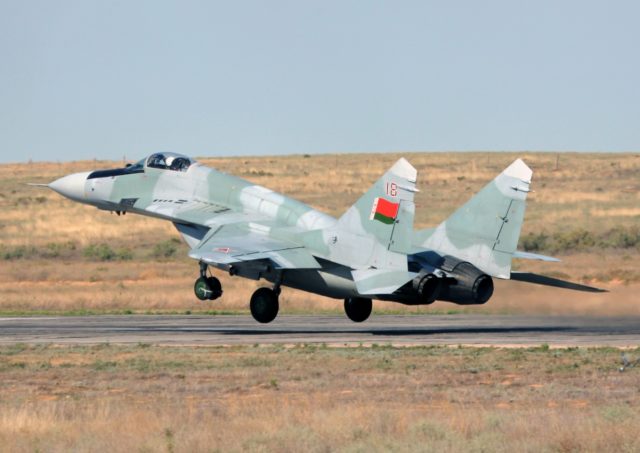
Lukashenka Agrees to Joint Air Patrols and Training Centers With Russia, but Still Opposes Military Base (Part One)
Publication: Eurasia Daily Monitor Volume: 18 Issue: 75
By:

The air forces of Russia and Belarus will begin joint air-defense missions out of one of the Belarusian airfields this summer. In reaching this agreement, Minsk and Moscow are resuming the practice of joint fighter jet patrols first started in 2013 but suspended two years later. The timing and broader circumstances of this sudden recommencement of such operations appear to signal a renewal of the Kremlin’s intentions to establish a permanent military presence in Belarus in the medium term.
According to the commander of the Belarusian Air Force and Air-Defense Forces, Major General Igor Golub, these joint missions with Russia are stipulated by the action plan (agreed to at the end of 2020) for on-duty air-defense forces within the framework of the Russo-Belarusian Unified Regional Air-Defense System (URADS) (Interfax, April 15). Although he avoided going into details when it comes to the reasons and parameters of the associated Russian Air Force’s deployment to Belarus, the experience from 2013–2015 provides some insight into what their likely activities this time will also consist of.
In 2009, Minsk and Moscow signed the agreement “on Joint Protection of the External Border of the Union State in Airspace and the Creation of the Unified Regional Air-Defense System of the Republic of Belarus and the Russian Federation.” However, that document only came into force in 2013, and two sides agreed on joint airspace patrolling missions solely on a rotational basis. Yet Moscow kept pushing. Soon, Russian Defense Minister Sergei Shoigu announced the creation of a Russian airbase in Baranovichi, Belarus, before then end of 2013, with a deployment of one fighter aircraft regiment by 2015. President Alyaksandr Lukashenka publicly denied the Moscow official’s words, emphasizing that the key issue under consideration was not one of creating an airbase but of supplying Russian aircraft to the Armed Forces of Belarus (Kommersant, April 29, 2013).
Nonetheless, in December 2013, four Russian Su-27P fighter aircraft landed at the 61st military airbase of the Belarusian Air Force, in Baranovichi, in order to take part in joint airspace patrolling missions (Tut.by, December 9, 2013). It was, to some extent, a response to the North Atlantic Treaty Organization’s (NATO) Baltic Air Policing mission, which protects the airspace of the three Baltic States of Estonia, Latvia and Lithuania. Moreover, Minsk’s decision to go ahead with the joint air patrols occurred amidst strained relations with Western countries—as a far-reaching echo of the December 2010 presidential elections, which were heavily criticized by most governments in Europe and the United States. Finally, and equally significantly, Moscow did not raise the issue of a Russian military base again until 2015, at which point the joint air patrols ended.
In September 2015, the Kremlin unilaterally announced that it had formalized plans to deploy a Russian military airbase with direct subordination to Moscow on Belarusian territory without Minsk’s prior consent (Pravo.gov.ru, September 7, 2015). President Lukashenka swiftly and firmly rebuked the overture, emphasizing that there were no relevant geopolitical or military-technical motivations for such a step (see EDM, October 7, 2015). The Belarusian leadership also abandoned the practice of joint air patrols with Russia in order not to escalate regional tensions, particularly in light of the ongoing Russian-Ukrainian conflict (Bellingcat.com, October 1, 2016). These decisions helped Minsk present itself as a neutral negotiating venue on the Russia-Ukraine conflict, formulate security guarantees toward all neighboring states, as well as normalize relations with the West, all while preserving and expanding Belarus’s strategic autonomy within its alliance with Russia (see Jamestown.org, March 2, 2020).
Nevertheless, Lukashenka’s repeatedly stated refusal to host a Russian military base did not stop the Kremlin. In November 2015, General Alexander Lyapkin, the chief of the Operations Directorate of the Main Staff of the Russian Air Force, declared that the staff and organizational structure of the anticipated Russian airbase had already been approved, and he appealed to the Belarusian side to speed up all necessary procedures to prepare the agreement for signing. According to him, Russian plans were to maintain one fighter squadron (12 Su-27 combat aircraft) and one rotary wing (4 Mi-8 transport-combat helicopters) at the airfield in Bobruisk (RIA Novosti, November 24, 2015). But still, Lukashenka’s government held firm for the next five years (see EDM, October 20, 2020 and October 28, 2020).
The political crisis that erupted as a result of the August 2020 Belarusian presidential elections sharply reversed these trends in Minsk, resulting in a significant aggravation of relations with the West and Belarus’s increasing dependence on Russian economic, political, and security assistance. The Kremlin has exploited Belarus’s sudden return to isolation from its European neighbors in order to expand Russian influence over its vulnerable ally.



